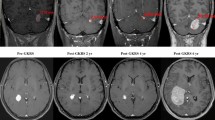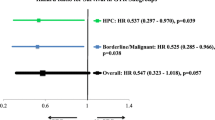Abstract
Increasing evidence has suggested a close relationship between solitary fibrous tumors (SFTs) and hemangiopericytomas (HPCs) in the central nervous system (CNS). However, CNS SFTs differentiate from HPCs in their clinical behavior and patient prognoses. Analyses of prognosis-related factors can help clarify the relationship between SFT and HPC. The intracranial SFT and HPC cases treated in our departments from January 2002 to December 2012 were retrospectively reviewed. The SFT and HPC cases were also combined into an SFT/HPC group. The factors associated with patient progression-free survival (PFS) and overall survival (OS) were statistically analyzed using uni- and multivariate analyses. Fifty-eight intracranial SFT/HPC patients including 38 SFT patients and 20 HPC patients were treated during this period. The “Marseille grading” evaluated upon the histological aggressive phenotypes was applied in this study. The grading reflected a malignant progression ranging from “conventional” SFTs (grade I) to WHO III HPCs (grade III), and grade was negatively correlated with the PFS and OS of the SFT, HPC and SFT/HPC patients (P < 0.05).The multivariate analyses revealed that gross total resection (GTR) was significantly positively correlated with PFS and OS in the SFT, HPC and SFT/HPC patients and that radiotherapy was significantly positively correlated with PFS in the HPC and SFT/HPC patients (P < 0.05). In conclusion, the intracranial SFTs and HPCs share common prognostic factors including extent of surgery and pathology, moreover, the histological grading of the aggressive phenotypes supports the unifying of the CNS SFT and HPC into one tumor entity of SFT/HPC.


Similar content being viewed by others
References
Thway K, Ng W, Noujaim J, Jones RL, Fisher C (2016) The current status of solitary fibrous tumor: diagnostic features, variants, and genetics. Int J Surg Pathol 24(4):281–292
Bisceglia M, Galliani C, Giannatempo G, Lauriola W, Bianco M et al (2011) Solitary fibrous tumor of the central nervous system: a 15-year literature survey of 220 cases (August 1996–July 2011). Adv Anat Pathol 18:356–392
Fargen KM, Opalach KJ, Wakefield D, Jacob RP, Yachnis AT, Lister JR (2011) The central nervous system solitary fibrous tumor: a review of clinical, imaging and pathologic findings among all reported cases from 1996 to 2010. Clin Neurol Neurosurg 113:703–710
Bisceglia M, Dimitri L, Giannatempo G, Carotenuto V, Bianco M et al (2011) Solitary fibrous tumor of the central nervous system: report of an additional 5 cases with comprehensive literature review. Int J Surg Pathol 19:476–486
Bouvier C, Métellus P, de Paula AM, Vasiljevic A, Jouvet A et al (2012) Solitary fibrous tumors and hemangiopericytomas of the meninges: overlapping pathological features and common prognostic factors suggest the same spectrum of tumors. Brain Pathol 22:511–521
Hayashi Y, Uchiyama N, Hayashi Y, Nakada M, Iwato M et al (2009) A reevaluation of the primary diagnosis of hemangiopericytoma and the clinical importance of differential diagnosis from solitary fibrous tumor of the central nervous system. Clin Neurol Neurosurg 111:34–38
Robinson DR, Wu YM, Kalyana-Sundaram S, Cao X, Lonigro RJ et al (2013) Identification of recurrent NAB2-STAT6 gene fusions in solitary fibrous tumor by integrative sequencing. Nat Genet 45:180–185
Chmielecki J, Crago AM, Rosenberg M, O’Connor R, Walker SR et al (2013) Whole-exome sequencing identifies a recurrent NAB2-STAT6 fusion in solitary fibrous tumors. Nat Genet 45:131–132
Yalcin CE, Tihan T (2016) Solitary fibrous tumor/hemangiopericytoma dichotomy revisited: a restless family of neoplasms in the CNS. Adv Anat Pathol 23:104–111
Moritani S, Ichihara S, Hasegawa M, Takada S, Takahashi T et al (2011) Dedifferentiation and progression of an intracranial solitary fibrous tumor: autopsy case of a Japanese woman with a history of radiation therapy of the head during infancy. Pathol Int 61:143–149
Gengler C, Guillou L (2006) Solitary fibrous tumour and haemangiopericytoma: evolution of a concept. Histopathology 48:63–74
Schweizer L, Koelsche C, Sahm F, Piro RM, Capper D et al (2013) Meningeal hemangiopericytoma and solitary fibrous tumors carry the NAB2-STAT6 fusion and can be diagnosed by nuclear expression of STAT6 protein. Acta Neuropathol 125:651–658
Ambrosini-Spaltro A, Eusebi V (2010) Meningeal hemangiopericytomas and hemangiopericytoma/solitary fibrous tumors of extracranial soft tissues: a comparison. Virchows Arch 456:343–354
Barthelmeß S, Geddert H, Boltze C, Moskalev EA, Bieg M et al (2014) Solitary fibrous tumors/hemangiopericytomas with different variants of the NAB2-STAT6 gene fusion are characterized by specific histomorphology and distinct clinicopathological features. Am J Pathol 184:1209–1218
Fritchie KJ, Jin L, Rubin BP, Burger PC, Jenkins SM et al (2016) NAB2-STAT6 gene fusion in meningeal hemangiopericytoma and solitary fibrous tumor. J Neuropathol Exp Neurol 75(3):263–271
Chen H, Zeng XW, Wu JS, Dou YF, Wang Y et al (2012) Solitary fibrous tumor of the central nervous system: a clinicopathologic study of 24 cases. Acta Neurochir (Wien) 154:237–248
Ramakrishna R, Rostomily R, Sekhar L, Rockhill J, Ferreira M (2014) Hemangiopericytoma: radical resection remains the cornerstone of therapy. J Clin Neurosci 21:612–615
Melone AG, D’Elia A, Santoro F, Salvati M, Delfini R et al (2014) Intracranial hemangiopericytoma–our experience in 30 years: a series of 43 cases and review of the literature. World Neurosurg 81:556–562
Reames DL, Mohila CA, Sheehan JP (2011) Treatment of intracranial solitary fibrous tumors with gamma knife radiosurgery: report of two cases and review of literature. Neurosurgery 69:E1023–E1028
Macfarlane RG, Galloway M, Plowman PN, Thomas DG (2005) A highly vascular intracranial solitary fibrous tumor treated with radiotherapy and toremifene: case report. Neurosurgery 56:E1378
Funding
No funding was received for this research.
Author information
Authors and Affiliations
Corresponding authors
Ethics declarations
Conflict of interest
All authors certify that they have no affiliations with or involvement in any organization or entity with any financial interest or non-financial interest in the subject matter or materials discussed in this manuscript.
Ethical approval
All procedures performed in studies involving human participants were in accordance with the ethical standards of the institutional and/or national research committee and with the 1964 Helsinki declaration and its later amendments or comparable ethical standards. For this type of study formal consent is not required.
Rights and permissions
About this article
Cite this article
Zeng, L., Wang, Y., Wang, Y. et al. Analyses of prognosis-related factors of intracranial solitary fibrous tumors and hemangiopericytomas help understand the relationship between the two sorts of tumors. J Neurooncol 131, 153–161 (2017). https://doi.org/10.1007/s11060-016-2282-y
Received:
Accepted:
Published:
Issue Date:
DOI: https://doi.org/10.1007/s11060-016-2282-y




